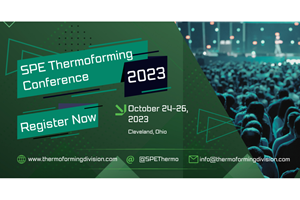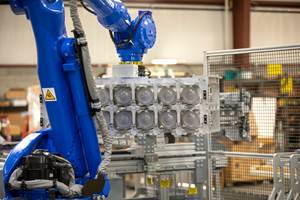Global Competition - Thin-Gauge Thermoformers Face Tough Competition
Competitive pressure from overseas manufacturers is being felt on different levels by U.S. thermoformers.
Competitive pressure from overseas manufacturers is being felt on different levels by U.S. thermoformers. Heavy-gauge formers for electronics, medical, and telecommunications applications face a limited threat due to the bulkiness of the parts and the cost of shipping them across oceans. But thin-gauge formers of disposable packaging face a stiff challenge from foreign exporters. The latest development is that U.S. thin-gauge formers are following their customers overseas.
Follow your customers?
High-volume, thin-gauge packaging for consumer goods such as point-of-purchase (POP) displays has seen inroads by overseas companies, encouraged by pricing pressures from “Big Box” retailers like Wal-Mart and Home Depot. Imports of blister packs, clamshells, and other packaging have crimped market growth for U.S. producers in all consumer segments except food and pharmaceuticals, notes consultant Jim Throne, president of Sherwood Technologies Inc., Dunedin, Fla.
And now, many U.S. OEMs are moving overseas and holding thermoformers’ “feet to the fire” in the process. “They’re saying, ‘Package for us overseas or we’ll find someone there who will,’” says Throne. He adds that these low-cost regions now offer better quality equipment and materials, which can positively affect a processor’s decision to relocate.
Privately held Placon Corp., a $100-million thin-gauge former in Madison, Wis., felt the heat from major customers who were leaving the U.S. In 2004, Placon opted to open a plant in China to make packaging for retail products like hardware and fishing tackle that are exported to the U.S. “It was a defensive move but we knew if we didn’t go to China, business would continue to erode here,” says president and CEO Jan Acker. The Chinese facility, which employs 30, makes retail packaging for the U.S. and food packaging for the local Chinese market.
Acker believes that this “defensive” move also had proactive benefits by putting Placon on the doorstep of a huge new market. Still, he believes thermoformers should think twice and make sure such a move is strategic to their business. “Don’t feel compelled to follow a customer abroad. Make sure you have something to bring to the market,” said Acker.
Privately held Prent Corp., Janesville, Wis., a maker of rigid packaging trays for medical, electronics, and consumer industries, has seen limited threat from overseas. However, the departure of U.S. electronics OEMs to the Far East forced Prent to set up operations in China and Malaysia. In the view of sr. v.p. of sales James O’Dierno, low-value packaging is the Achilles heel of U.S. thin-gauge thermoformers, who must adapt to changing global supply needs by finding niches and “higher-tech” applications. For example, thin-gauge formers are relatively immune to overseas competition in food and pharmaceutical markets due to speed-to-market needs and a steep learning curve to meet regulatory requirements.
Low threat in heavy gauge
The global environment for heavy-gauge thermoformers is considerably less intense, with overseas pressure focused on less complex parts like high-volume covers and enclosures for electronics. Low-volume parts that are large, intricate, and expensive to ship are mostly off-limits to offshore companies. As a result, none of the industrial thermoformers interviewed for this article has plants outside the U.S.
Some pressure from Asian manufacturers comes indirectly from processes like injection molding, structural foam, and polyurethane RIM, in which overseas processors are gaining proficiency. “Those processes are cutting into the North American thermoforming market,” says Haydn Forward, v.p. of sales for Specialty Manufacturing Inc., a $7-million heavy-gauge former in San Diego. Specializing in short runs (1500 parts or less per year), Specialty Manufacturing produces intricate tight-tolerance parts that pose a steep learning curve for would-be competitors abroad. Haydn says one of the benefits of the so-called “China threat” has been greater attention by his firm to lean manufacturing principles that eliminate waste, improve quality, and reduce overall cost.
Freetech Plastics, Freemont, Calif., is another industrial former that does highly detailed and decorative enclosures and housings for telecommunications. President Richard Freeman sees limited pressure from Asia in low-end applications like ABS and PC covers. However, his company has a niche that few overseas companies want to pursue, due to the low volume and high precision required. Freeman and others agree that the primary focus of low-cost operations in regions like China is high-volume parts of low complexity.
Some companies like Universal Plastics, Holyoke, Mass., have lost business from the relocation of large OEM customers–primarily in electronics–to the Far East. But after losing selected applications like small to medium-size enclosures and covers, Universal has seen a boost in its large-parts business. Ironically, the company is even exporting large intricate E/E covers to China because the OEM can’t find a local source, says president Joe Peters.
Smaller firms like Universal can withstand offshore competition by focusing on value-added products in small to medium volumes, according to Peters. “Complex parts are not likely to be sourced to distant suppliers because if there’s a problem the customer can’t afford to wait,” he explains.
Technology can also be a differentiating factor, according to Brian Ray, president of Ray Products Inc., Ontario, Calif. Last year, the company started up the largest rotary thermoformer in the western U.S. It has a forming area of 10 x 18 ft and will enable Ray Products to pursue super-large applications open to few foreign or domestic processors.
Related Content
Thermoformer Maximizes Productivity with 3D Printing
Productive Plastics has created an extensive collection of 3D printed manufacturing aids that sharply reduce lead times.
Read MoreClock's Ticking: Register Now for 2023 SPE Thermoforming Conference
Three-day event kicks off Oct. 24 in Cleveland.
Read MoreNovel ‘Clamtainer’ Extends Thermoformer's Reach in Packaging
Uniquely secure latching expands applications for Jamestown Plastics’ patented clamshell package design.
Read MoreAn Automation 'First' for Non-Servo-Eject Trim Presses
Compact, flexible and configurable robotic system is said to be the first to enable thermoformers to fully automate product handling after a non-servo trim press.
Read MoreRead Next
Understanding Melting in Single-Screw Extruders
You can better visualize the melting process by “flipping” the observation point so that the barrel appears to be turning clockwise around a stationary screw.
Read MorePeople 4.0 – How to Get Buy-In from Your Staff for Industry 4.0 Systems
Implementing a production monitoring system as the foundation of a ‘smart factory’ is about integrating people with new technology as much as it is about integrating machines and computers. Here are tips from a company that has gone through the process.
Read MoreWhy (and What) You Need to Dry
Other than polyolefins, almost every other polymer exhibits some level of polarity and therefore can absorb a certain amount of moisture from the atmosphere. Here’s a look at some of these materials, and what needs to be done to dry them.
Read More

























